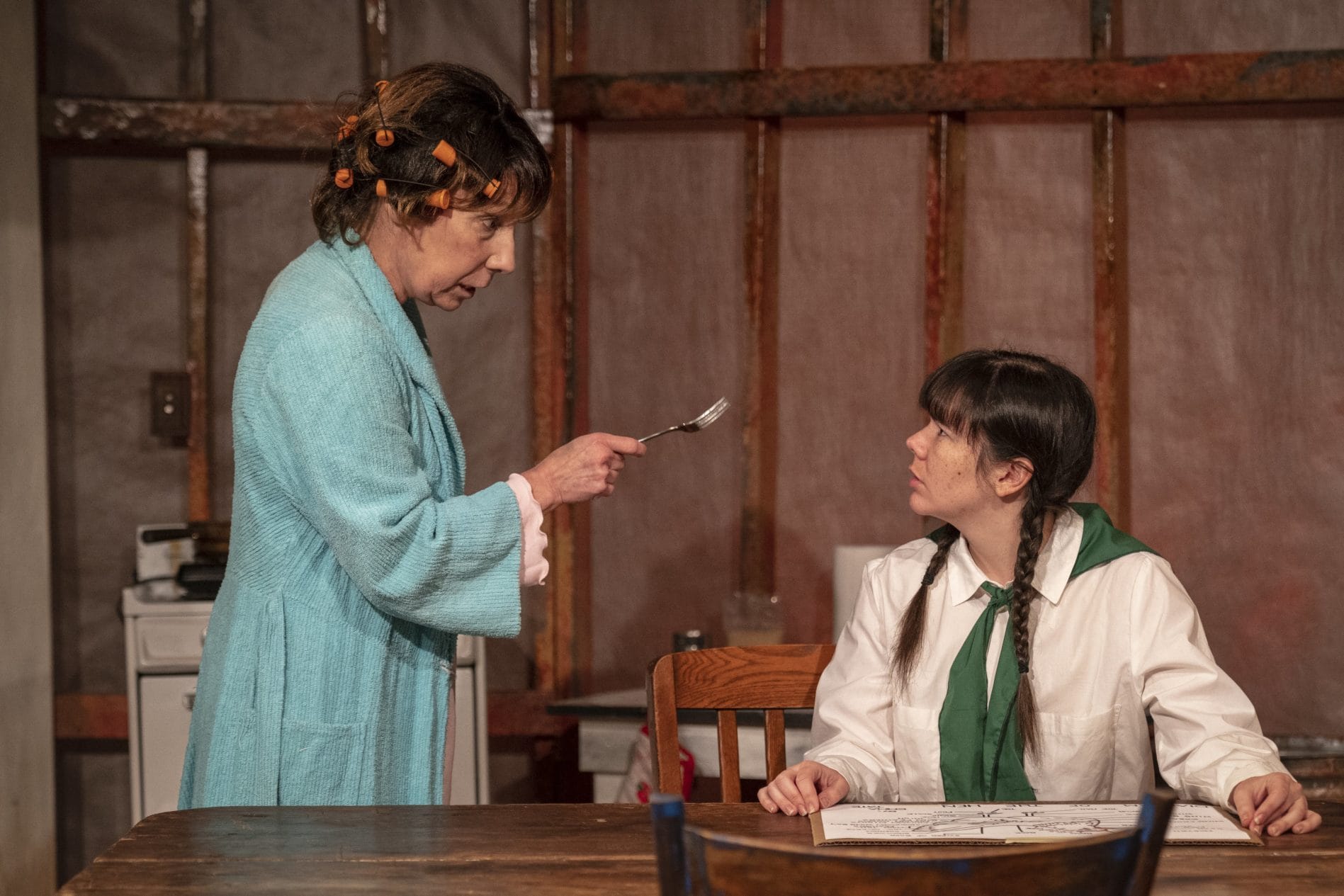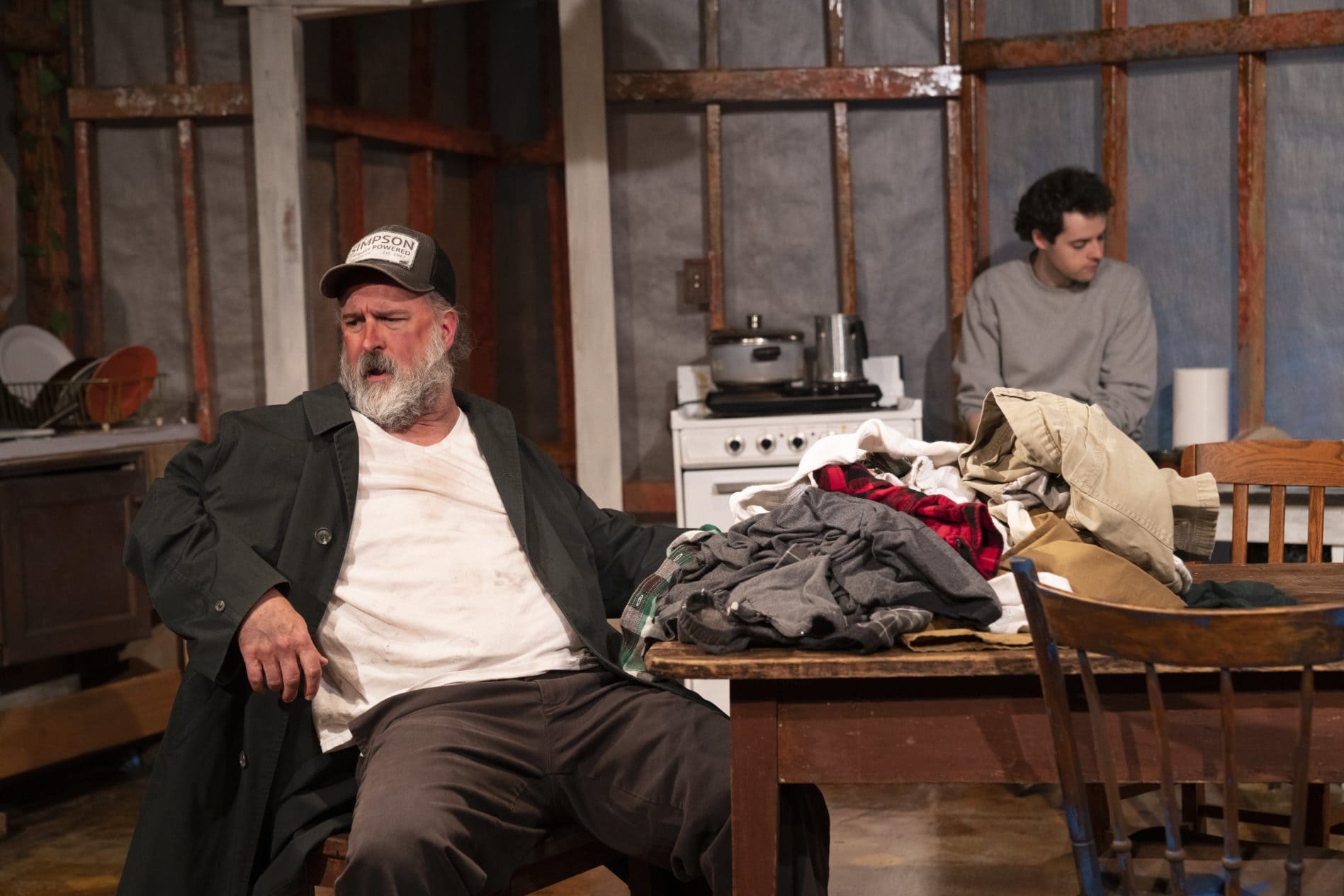When we first see the Tate family in Sam Shepard’s Curse of the Starving Class, now playing at Frederick’s Maryland Ensemble Theatre (MET), they are already doomed, they just don’t fully know it yet. In their broken-down, hardscrabble, Southwest house, each family member pursues his or her own dream – fantasy might be a better word – of a better life. Director Peter Wray brings together the characters and setting to create a taut, unsettling portrait of a family and way of life in dissolution, leavened sporadically by bitter, dark humor.

The marriage of Weston (Tad James) and Ella (Julie Herber) is irretrievably broken before the play begins. Each is trying to sell the homestead out from under the rest of the family without telling the other. For Ella, in cahoots with Taylor, an unctuous, smarmy lawyer/land speculator (J.D. Sievert), it is to finance her dream of a beautiful vacation, or even life, in Europe. The oft-drunken Weston is drowning in debt to violent local loan sharks for a variety of foolish expenditures – old cars, a worthless piece of land — that let him feel that somehow things can be different. Meanwhile, their teenage daughter Emma (Karli Cole) imagines herself a heroic auto mechanic in Mexico, while their 20ish son Wesley (Sean Byrne) seeks contentment in an imagined future in a fixed-up version of their present home.
Shepard, for all his dyspeptic view of life, gives his actors meaty roles with plenty of physical and vocal range. The MET cast takes full advantage. Cole, for example, plays the youngest member of the family for her enthusiasm and impulsiveness, despair not yet having crept into her bones. She derives a palpable sense of hope from thoughts of escape. Byrne effectively conveys Wesley’s contradictions: he’s trying to fix things, yet steps on the dreams of others; he’s realistic, but afraid of his father and probably himself.
Shepard structures the play largely around monologues, and the leading quartet make the most of their opportunities with them. James has two of the best, which he delivers musically, almost as spoken arias, one concerning his homicidal anger at those who he feels have done him wrong (delivered lying on a table amidst a pile of dirty clothes) and another about a near-mythical encounter with an eagle. From drunken rage to a sobered-up state of denial, James provides a full-bodied rendering of Weston’s lost soul.
Herber delivers one striking speech to the empty refrigerator, a symbol of the family’s position in the “starving class,” asking repeatedly why it is never surprisingly full of food. Later on, her dreams dashed, her Ella is utterly exhausted. It’s a strong moment for Herber; it takes real energy on the part of an actor to play bone-weariness that convincingly.
The show’s title has very intentional and literal meanings. The family sees itself as cursed. The characters talk of “liquid dynamite” – nitroglycerin – coursing through their veins, manifesting itself especially in the men’s explosive anger. They speak of indwelling “poison” as a family trait – there is a tradition of alcoholism, rage, and general dysfunction among the generations of the family. Wesley describes the encroaching real estate development as a zombie invasion.

In addition to first-rate acting, MET has mounted an excellent technical production. The details of Ira Domser’s set tell the story not only of the physical house, in all its decrepitude, but of the despair within. Devin Gaither’s props, prominent piles of laundry, scattered pieces of a door, and a bunch of artichokes, stand out.
Jennifer Adams’ costume changes make important points about the characters. Weston begins with a disheveled old coat and is dressed neatly in the final scene. Ella begins in a drab robe, her hair in curlers, but spruces herself up when she is going out for a “business lunch” with Taylor as she tries selling the house to him. Emma is first in a white 4-H outfit, but returns with it covered in mud after a fiasco with a horse that thwarted her first escape attempt. Wesley begins in an informal outfit, but sheds it in the final scene, returning in his dad’s old coat, dug out of the trash.
There is social commentary in the play, some of which dramaturg Caitlin Joy highlights through displays in the theater’s hallway. Poverty destroys on not just a physical but a spiritual level. The forces of “economic progress” create winners and losers: the winners are schemers like Taylor, the losers people who haplessly cross their path. With its lines about uncontrolled real estate development and people’s tendency to borrow beyond their means in the belief that accumulation will somehow fulfill their longings, Curse of the Starving Class, first produced in 1978, took on even greater resonance 30 years later when the subprime mortgage crash nearly brought down the economy.
In the play’s grimness, there is disaster but not tragedy. There are moments where one might be tempted to think of Weston as a sort of drylands Willy Loman, but he and many others in Shepard’s plays are laid low from the start; there are no relative heights from which they can fall. In Shepard’s world, attention need not be paid to such a man, not even, ultimately, by his own family. But audiences will want to pay attention to the production that brings Weston and his family to unhappy life.
Running Time: 2 hours and 25 minutes, including one intermission.
Curse of the Starving Class is playing through April 28, 2019, at Maryland Ensemble Theatre, 31 W. Patrick Street, in Frederick, MD. For tickets, you can call 301-694-4744 or go online.




